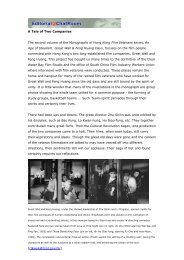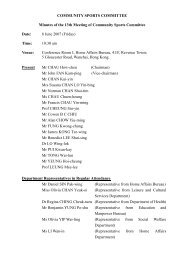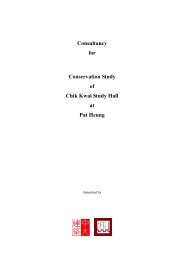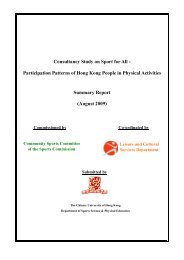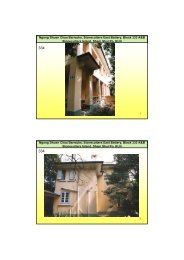Download Newsletter Issue 6
Download Newsletter Issue 6
Download Newsletter Issue 6
Create successful ePaper yourself
Turn your PDF publications into a flip-book with our unique Google optimized e-Paper software.
Acquisition is comparable to a game of treasure hunt. Each time there is a clue,<br />
we pursue it actively to locate the source. Then a process of persuasion takes<br />
over whereby permission is sought from the owner to deposit or donate a film<br />
print or any other documentary materials. In the process of the search, naturally<br />
we may hit upon surprises or new discoveries. Each surprise finding has a story<br />
to it...<br />
Local Treasures I: The Moving of the Golden Harvest Studio<br />
The last days of the Golden Harvest Studio was as busy as usual, with staff packing and sealing boxes.
It's October 30th - the last two days at the Golden Harvest Studio before it<br />
moved out of Hammer Hill Road.<br />
With the generous support of the Golden Harvest Ltd, the Film Archive received a<br />
bulk of the studio's library of film prints and documents. Together with the<br />
Acquisition Unit, we arrived at the studio premises on this day to collect the<br />
historical materials, and hence the chance to bear witness to the studio's moving<br />
event.<br />
It's difficult to bid farewell to the two big iron gates which have stood there for<br />
over 40 years. These gates were still inscribed with the alphabets "YH", denoting<br />
Yung Hwa, a studio that marked another era in our film history. The gates are still<br />
glittering under the sun as we passed by. It's sad to bid farewell to the shooting<br />
chambers, props storage rooms and the subtitling rooms where many great films<br />
were made in the confines of these shooting set-ups, not to mention those who<br />
have sweated and even shed blood to make the pictures. Bidding farewell was<br />
equally hard to those huge Bruce Lee posters that have been hung there for<br />
twenty years, as well as the motorcycles used by Jackie Chan in Police Story<br />
(1985).<br />
The removal of the Golden Harvest studio away from its old Diamond Hill site<br />
signaled the turned of another chapter in the development of the history of Hong<br />
Kong cinema. On that site, a large slice of Hong Kong cinema's production history<br />
took place for nearly half the century. On that site, cinematic trends and fads<br />
came and went, from 1955, when the Yung Hwa Studio was established, to the<br />
mid-50s, when the premises were taken over by the MP and GI Studio (later the<br />
renamed Cathay), to the 70s when Golden Harvest finally took over. Establishing<br />
the internationally-known stars such as Bruce Lee, Jackie Chan, and Michael Hui,<br />
Golden Harvest became a pillar of the Hong Kong film industry, and it spouted off<br />
many co-production companies such as Golden Way, Bo Ho, Hui Brothers, etc.<br />
Time was running out. The staffs, while busy packing stuff into boxes, were also<br />
discussing about where to take the big group photo on the following day. As<br />
truckloads of studio belongings were moved out of the premises, some boxes<br />
made their way to the Hong Kong Film Archive...<br />
The final tally of our collection from the studio reaches over 200 films, adding to<br />
them are other film-related materials like posters, film stills, brochures and film<br />
magazines.
Local Treasures II: The Collection That Risked Life<br />
The Eight Hundred Heroes (1938): surviving the ravages of war.<br />
Mr Daniel Wang was a devoted film lover in Shanghai back in the 1930s. He ran a<br />
film processing laboratory named Yin Guang (or Silver Light), and had helped<br />
process many anti-Japanese patriotic features and documentary films. In 1937,<br />
Mr Wang decided to move his whole family to Hong Kong, taking along with them<br />
his collection of film prints and negatives. Having settled in Hong Kong, Mr Wang<br />
reopened his film laboratory. However, in 1941, the war was spread to Hong<br />
Kong and knowing that the films he owned would caused him a lot of trouble if<br />
discovered by the Japanese, Mr Wang closed down his lab and turned to the<br />
manufacturing of household goods. He took quick action to bury his film collection<br />
in the ground underneath his shop. It wasn't until after the war that this<br />
collection was unearthed.<br />
Because of Mr Wang's love for cinema, we are now able to see some of the<br />
classics from his 1930s collection, including The Eight Hundred Heroes (1939),<br />
Protect My Country (1939) and Scenes of Yan'an (1938). These classic films,<br />
having been moved about over ten locations, have survived the revages of war.<br />
They are now in the possession of the Hong Kong Film Archive due to the<br />
generous arrangement of Ms Dolores Wang, daughter of the late Mr Daniel Wang.<br />
Local Treasures III: The Stars' Shining Support<br />
It was Chow Yun-fat who first showed his support of the Hong Kong Film Archive<br />
by generously donating all the awards he has won to the Archive. Following on<br />
Chow was Josephine Siao and her awards now become part of the Archive's<br />
treasures. The support of these two superstars formed the linchpin which allowed<br />
the Archive to communicate with other actors and film personalities and helps<br />
substantiate the Archive's future acquisition.
What readers may not know is that the Archive has already signed agreements<br />
with veteran superstars, such as Li Lihua, Fong Yim-fen, etc, allowing the Archive<br />
to take in as research materials any film materials related to their work of which<br />
they have copyrights.<br />
Local Treasures IV: Closure of Cinemas<br />
The Acquisition Section is always on red alert for signs or announcements of<br />
cinema closures or deaths of film personalities, for such occasions, sad as they<br />
ultimately are, provide opportunities for the Archive to add to its collection.<br />
Over the last two years, many theatres have had to close down, such as the<br />
State Theatre (March 1997), Liberty Theatre (September 1997), United Theatre<br />
(May 1995), Fairview Theatre (August 1998), The Yuen Long Palace Theatre<br />
( August 1998) and Yau Ma Tei Theatre (July 1998). Witnessing these a relatively<br />
new cinema winding up its operations is a sad sight to behold.<br />
Overseas Adventure I: An Orphan in England<br />
The Orphan (1960) with Ng Cho-fan and Bruce Lee.<br />
There is probably no tale stranger than the one we have to tell about how a Hong<br />
Kong film laid in the vaults of the Rank Film Laboratory, England, for over 30<br />
years undiscovered until a staff member of the Hong Kong Film Archive visited<br />
the laboratory on an observation tour and found the negatives. The Orphan<br />
(1960) lying on a shelf. The Orphan, directed by Lee Sun-fung, was the last film<br />
to star the teenaged Bruce Lee before he left Hong Kong for America.<br />
Apparently, it was the practice for some Hong Kong film production companies to<br />
process the colour negatives of their films overseas in those days. This way, some<br />
negatives of Hong Kong films have been forgotten and left on shelves in distant<br />
foreign lands for decades.
The Orphan thus acquired was an Eastman-colour production. Prior to this<br />
discovery and restoration of The Orphan, the only version of the film shown on<br />
Hong Kong TV was a grainy black-and-white copy.<br />
Overseas Treasures II: San Francisco<br />
Home-coming: the reowned Hong Kong classic films in San Francisco's World Theatre were transported back<br />
to Hong Kong.<br />
The largest overseas acquisition exercise took place in San Francisco's Chinatown.<br />
In 1996, news was received that the famous World Theatre was to revamp its<br />
operations and change management. The theatre would no longer show old<br />
Cantonese films and thus its stock of over 600 Chinese classic films would be<br />
redundant. The Acquisition Section entered into negotiations with the World<br />
Theatre and finally succeeded in bring in this library of classic Hong Kong films to<br />
the Film Archive. Many of the films in this collection were originally thought lost,<br />
such as Fisherman's Song of the South Sea (1950), So Far Yet So Near (1952),<br />
Aren't the Kids Lovely? (1953) and A Mother's Tear (1953), etc.<br />
At present, the Acquisition Section attempts to get in touch with other theatres in<br />
Chinatown in the hope that other forgotten or lost classics will be retrieved.
Overseas Treasures III: Southeast Asia<br />
Being one of the Hong Kong film industry's major markets and favourite spots for<br />
location shooting, Southeast Asia is almost a second home for many Hong Kong<br />
film industry insiders, such as producer Chua Lam. Chua Lam's father, Mr. Chua<br />
Boon-hean, lived in Singapore, and through his work associated with Shaw<br />
Borthers, kept a collection of rare screenplays. The scripts were finely bound into<br />
hard-cover volumes. After obtaining agreement from the Chua family, a huge<br />
part of his collection is now in the safekeeping of the Archive.<br />
In addition, during a visit to Japan by our Senior Manager Ms Cynthia Liu, two<br />
rare Hong Kong films were discovered at the Kawakita Foundation. With the<br />
Foundation's kind donation, these two classic pictures starring Li Lihua - What<br />
Price Beauty? (1954) and Blood Will Tell (1955) now also come under the Archive<br />
collection.<br />
Preserving Film Heritage: Searching with a Mission<br />
Ms Angela Tong, Manager of the Acquisition Section, has witnessed how film<br />
acquisition develops at the Archive for the past two years. She has clocked up an<br />
experience which allows her to grasp the historical significance of preserving<br />
Hong Kong's film culture. Below is an interview with Ms Tong.<br />
Q: There are so many film materials. Apart from the film prints themselves, there<br />
are printed materials, posters, stills, etc. How do you go about collecting them?<br />
A: We follow leads given to us either by insiders within the film industry or local<br />
and overseas friends who give us information. For example, in the case of King<br />
Hu's The Valiant Ones (1975), we learned that the negative of the film was still<br />
placed in a laboratory in Hong Kong through a friend of Mr Law Kar, programmer<br />
in the Hong Kong International Film Festival. We conducted investigations of our<br />
own to establish the veracity of this information, then we contacted the late<br />
director himself to get his consent. After agreement had been established, we<br />
then proceeded to arrange it to be donated to the Archive. It's more or less the<br />
same for other acquisitions.
Q: What is the biggest difficulty faced by the Acquisition Section?<br />
A: The Film Archive was established somewhat late in the day and over the years,<br />
many films have been lost. In contrast with many other countries, we have a lot<br />
of gaps to fill. Unlike some countries which demand legal deposit, Hong Kong<br />
does not have such a law and that's why we have to take the initiative ourselves<br />
to contact the film production companies and explain to them our work and the<br />
kind of facilities we have, etc. There's a long way to go for film preservation.<br />
Sometimes, the companies might have the misunderstanding that once a film is<br />
delivered to the Archive, they will no longer be able to use it or retrieve it. In<br />
fact, the owner can retrieve the film where necessary so long as the adhere to<br />
the principle "preservation". The rights naturally still belong to the owner.<br />
Q: Are there any unforgettable moments that you have come across?<br />
A: Acquisition is like looking for treasure. Your instincts have to be sharp. Once<br />
there's a lead, you have to follow it up immediately. We do come across a lot of<br />
happy surprises. My most profound impression was the generous donation by Mr<br />
Kwan Hon-chuen, son of the late Kwan Tak-hing, who donated many of the<br />
materials relating to his father's career and he has now become a good friend of<br />
the Archive. Recently, he came across a stack of well-preserved handbills of Hong<br />
Kong films from the 60s in San Francisco, and this is now in the Archive's<br />
possession. There's also Mr Cheng Fat-ming, a collector, who would buy film stills<br />
with his own money and then donated them to the Film Archive.<br />
Another person I admire is Miss Dorothy Au, a fan of the actress Hsia Moon. She<br />
told us she was very fond of her private collection but in order to let others share<br />
in it, she generously donated it to the Archive. Such selfless spirits have given us<br />
a lot of encouragement. Enormous support has also been shown by film<br />
companies such as Sil-Metropole Organisation, which readily authorise us to<br />
acquire films under their ownership. Because of our work, we come across a lot of<br />
veteran producers and film workers who are all very friendly. They regularly call<br />
us up and ask us out for tea or lunch. Such are bonuses of our regular acquisition<br />
work!<br />
Q: The Acquisition Section is regarded as the Archive's front line with its<br />
extension to the outside world. Do you feel being involved in a mission?<br />
A: The Acquisition Section does often take a pro-active role. In the beginning, our<br />
department often faced up to a brick wall, so to speak. Many film companies<br />
found us annoying because it meant extra administration work for them, whether<br />
it was donation or deposit. In time, they came to feel that our work was
important and that the Archive would help them to preserve their most precious<br />
films for posterity. We therefore succeeded in collecting some very rare and<br />
precious films and this made us feel that we were taking part in a grand project. I<br />
think that the slogan "mending while preserving" that we used in our Collection<br />
Campaign is very fitting and exactly this makes our work so meaningful.<br />
We often witness the decay of many film prints due to the unfavourable storage<br />
conditions, to the extent that they have turned rotten and become irrecoverable.<br />
The earlier these prints could get into the hands of the Archive, the better the<br />
chance for them to be preserved. We also know that many movie fans might<br />
possess film prints of other film materials at home. If they could think ahead, the<br />
best way to preserve these materials and let them be of use to more people is to<br />
donate or deposit them to the Archive.<br />
Manager of the Acqusition Unit, Ms Angela Tong.<br />
Ms Tong on one of her acquisition trips.
We witnessed the decay of many film prints due to unfavourable storage conditions.
Besides the valuable hard-cover scripts kept by his late father, Mr Chua Lam has<br />
also donated many film-related books from his own collection.<br />
Mr Edwin Kong of EDKO Communications Ltd donated a few film prints directed<br />
by himself, including a documentary, Rising Sun (79), which carries important<br />
footages of the anti-Japanese War and the World War II.
Handbills of 1960s Hong Kong pictures distributed by a San Francisco Chinatown<br />
theatre, Great Star, a donation of Mr David Quan. These handbills carry<br />
information and synopses of over two hundred Hong Kong films.
Following the publication of the Hong Kong Filmography, Volume Two, the Archive<br />
has sent out questionnaires to our advisers and a meeting with film experts was<br />
also held to review this volume and discuss the preparation work of the next<br />
publication, particularly relating to its research and editorial direction.<br />
We have received much favourable response and positive feedback on Volume<br />
Two. Among them:<br />
Mr Shu Kei finds the Filmography "all very satisfactory" and urges the Archive to<br />
keep up with the good work.<br />
Mr Ng Ho regards the extracted information and quotations from the original film<br />
brochures as very valuable reference materials and as Volume Three chronicles<br />
films of the 50s where such materials are abundant, emphasis should be placed<br />
on enriching these texts. He further suggests a selection of only the finer original<br />
film stills for publication.<br />
Mr Dennis Chan gives credits to the layout, content and appended notes of the<br />
Filmography, saying that the information presented is "very complete and clear",<br />
commenting the design and layout as "A Class", and that "no effort (of the<br />
Archive) is wasted".<br />
These and other feedback and reviews will be taken into consideration by our<br />
Research and Editorial Units while preparing for the coming volumes. More than<br />
2,000 local productions were produced in the 50s and it is our aim to chronicle<br />
more film titles in the coming volume so as to speed up publication of the whole<br />
Filmorgraphy series.
y Frank Bren<br />
Editor's Note:<br />
The debate continues. In what year exactly were the first films ever<br />
shown in Hong Kong? Who was responsible for these first showings<br />
using what projector? Were they in any way related to the Lumiere<br />
photographers who were dispatched all over the world by the Lumiere<br />
Brothers to show their new found inventions? All these questions have<br />
been touched upon by various researchers before. In this issue, we<br />
publish an article by Mr Frank Bren that continues the debate. Mr Bren<br />
has researched into early English-language newspapers and followed up<br />
on the previous analyses, coming up with his own formulations. His<br />
article also brings up other interesting questions for more scholarly<br />
research, and is a significant contribution to the study of Hong Kong's<br />
early film history.<br />
Early Cinema in Hong Kong<br />
The Cinematograph first came to Hong Kong with a whiff of piracy.<br />
Like "Nike" or "Sony", Cinematograph[e] was a trade name, belonging to the<br />
acknowledged inventors of cinema, the Lumiere brothers in France. From 1896,<br />
Lumiere representatives were touring the globe, promoting the invention and<br />
making films, so it seems natural that a Frenchman should be the first to publicly<br />
exhibit the Cinematograph in Hong Kong.<br />
That is indeed what happened.<br />
Hong Kong - First Port of Call<br />
On April 23, 1897, "Professor Maurice Charvet", supposedly from Paris, arrived in<br />
Hong Kong aboard the Peru, direct from San Francisco. The newspapers,<br />
announcing his arrival, were enthused by the 'Cinematograph' and 'Kinetoscope'<br />
he had brought for a series of film exhibitions at City Hall. The machines were the<br />
scientific marvels of the age and, according to the Hong Kong Daily Press, "the<br />
marvels have not been in Hong Kong before, but everybody has heard of the<br />
astonishing pictures they throw on to the screen" (26/4/1897). Said the China<br />
Mail: "These marvels have never been shown in Hong Kong or the Far East<br />
before" (24/4/1897).
Somehow, the alleged Kinetoscope then disappeared. In City Hall, on Monday,<br />
April 26, Mr Charvet ran a press show of the Cinematograph alone. He projected<br />
short films depicting the entry of the Czar into Paris, the march past of a<br />
regiment of French cavalry and "queer bits from out-of-the-way corners of the<br />
world". With one reservation ("a rather irritating quiver"), the newspapers hailed<br />
this astounding marriage of photography and electricity, adding that the life-like<br />
photographs passed "the lenses, at the rate of fifty per second."<br />
News cutting from The Daily Press (HK) over a century ago.<br />
Unfortunately, the next day's scheduled opening was cancelled. As Mr Charvet<br />
announced: "The delicate and intricate mechanical arrangements combined with<br />
the elaborate and most modern of electrical appliances of the machine require<br />
such perfect adjustment and manipulation that Professor Maurice Charvet has<br />
decided to Postpone his Opening Exhibition for One Day". In other words, the<br />
machine malfunctioned.<br />
But his hour-long show successfully opened on Wednesday morning, April 28,<br />
running 5 times daily until at least May 4. The images were still jumpy but<br />
business boomed for, according to "Notes from the South" (14/5/1897) in The<br />
Peking and Tientsin Times, "the Cinematograph has been exhibiting in St<br />
Andrew's Hall [in City Hall], attracting large audiences every day".<br />
Hong Kong was Mr Charvet's first port of call. In June, he headed for Shanghai, to<br />
prepare further exhibitions of his Cinematograph in China.
Five Cinema Shows in Year<br />
On August 21, in City Hall's Theatre Royal, a rival presented the Animatoscope<br />
("Edison's latest wonder"), which had already appeared before "Sir Claude<br />
McDonald at the British Legation, Peking." Indeed, on July 24, The Peking and<br />
Tientsin Times had favourably compared the Animatoscope over its rival,<br />
Charvet's Cinematograph. The former's "300,000 to 400,000 photographs" were<br />
"thrown on the sheet at the rate of forty-eight per second, so that they appear to<br />
be continually moving without any interruption."<br />
On October 16, Charvet, with his partner, a "Professor Johnson", returned for<br />
another season, this time in the Theatre Royal, with 17 shorts. Subjects included<br />
Queen Victoria's Jubilee procession in London, a comic Dispute between<br />
Bicyclists, Parisian scenes such as the Place de la Concorde and Seine River, an<br />
intriguing The Haunted Castle plus sundry other titles, all rather like a Lumiere<br />
repertoire. Unfortunately, the images sometimes shook and some had "a haziness<br />
of outline which detracted slightly from their value".<br />
Advertisement from The Hong Kong Telegraph on Oct 16, 1897.<br />
On January 23, 1898, the Animatoscope returned, this time playing at No 5,<br />
Arsenal Street, Queen's Road East, under the proprietorship of Naftaly Bros.
Then, on April 2, 1898, conjuror Carl Hertz brought his famous stage show to the<br />
Theatre Royal, featuring a Cinematographe with a vast repertoire of movies ("200<br />
subjects"). "You are not up to date," Hertz warned, "if you fail to see the Original<br />
and Marvellous Cinematographe, recently the Craze of the West!" Short dramas<br />
and comedies like The Death of Nelson, The Widow's Kiss and The Nightmare<br />
wowed HK audiences. "The Cinematograph is far beyond those previously<br />
exhibited here." waxed a reporter, though another complained that it was "less<br />
steady than the last 'squintograph' exhibited here." Hertz' show ran until at least<br />
April 16.<br />
For Hong Kong, it was a busy time, moviewise - five exhibitions in a year!<br />
Pirates and Underground Movies<br />
The above list of facts - and other recent discoveries - from contemporary<br />
newspapers in English, based in either Hong Kong or mainland China 1 , offers a<br />
new chronology for the earliest film shows in the territory. However, the<br />
discoveries raise other questions.<br />
Was Charvet's Cinematograph the first such machine to operate in Hong Kong, let<br />
alone the "Far East" as claimed in the China Mail?<br />
The statement is supported - twice - by Shanghai's own North China Herald<br />
(28/5/1897) which reviewed a May 22 performance of the Animatoscope in Astor<br />
Hall, Shanghai. It was "the first opportunity in Shanghai of witnessing the<br />
demonstration of the wonderful machine which under a variety of names has<br />
become so popular" and a "marvellous advance upon the familiar optical lantern."<br />
On September 10 that year, the same journal called Charvet's Cinematograph a<br />
"comparative novelty" for the Shanghainese: "Previously this modern and very<br />
clever adaptation of photography has only had one exhibit" (i.e. May 22, as<br />
above).<br />
But the Institut Lumiere in Lyon, France, says otherwise - that the Societe<br />
Lumiere (Lumiere Company) organised film shows at a venue in the Xu Gardens,<br />
Shanghai, on August 11, 1896. This is well documented - though vaguely and<br />
without mentioning the name 'Lumiere' - in several writings on the history of<br />
Chinese cinema. The primary source appears to be 2 contemporary<br />
advertisements in the Shanghai daily, Shen Pao.
The right to use 'Cinematographe', adds the Institut's Fabrice Calzettoni, "was<br />
definitely the property of Lumiere, but was impossible to protect. We estimate<br />
that, starting in 1896, over 600 copycat machines were soon manufactured or<br />
patented in France alone. So, unauthorised screenings under the<br />
'Cinematographe' name could easily have been done a year later in Hong Kong...<br />
As for the name Maurice Charvet, we have no record."<br />
Writer Clive Sowry 2 notes that, in 1896, the Lumieres refused Carl Hertz the right<br />
to use a Cinematographe in his show and that the latter obtained another<br />
projector from inventor Robert W Paul. But Hertz billed it as a "Cinematographe"<br />
in his show.<br />
Did Charvet and Hertz, therefore, flout the trademark laws? And what of the<br />
suspiciously named "Ripograph" - a "giant Cinematograph" that successfully did a<br />
season in Singapore from May 12, 1897?<br />
Perhaps there were other, more clandestine exhibitions in Hong Kong and China.<br />
With the Lumiere Cinematographe having played London in February, 1896, a<br />
pirated 'Cinematograph' could certainly have made it to China - with Hong Kong<br />
as a first port of call - during 1896. Like the video, VCD or DVD pirates of today,<br />
the carriers may have shunned publicity.<br />
The court rests.<br />
Note 1: ie, of the English-language press: China Mail, Hong Kong Daily Press (HK), and The Hong Kong<br />
Telegraph.<br />
Note 2: In his article, "The Illusionist and the Cinematograph (The Big Picture, <strong>Issue</strong> 11, Summer 1997).
First Screenings of Motion Pictures in Hong Kong<br />
First Date: Name of system: Venue: Critical comments:<br />
From 28/4/1897<br />
(Wed) at 11am<br />
until at least May<br />
4<br />
From 21/8/1897<br />
(Sat) until at<br />
least August 28<br />
(Sat)<br />
From<br />
16/10/1897<br />
(Sat) until at<br />
least Oct 20<br />
(Wed)<br />
23/1/ 1898<br />
(Sun)<br />
2/4/1898 (Sat)<br />
until at least<br />
April 16 (Sat)<br />
26/12/1899<br />
(Tue) until at<br />
least Dec 30<br />
(Sat)<br />
"Cinematograph", as<br />
presented by Professor<br />
Maurice Charvet.<br />
H. Wellby-Cooke presented<br />
the "Animatoscope"<br />
("Edison's Latest Wonder"<br />
"Cinematograph" as<br />
presented by Professors<br />
Johnson & Charvet<br />
"Animatoscope" - return<br />
season<br />
"Cinematographe" as<br />
presented by "London"<br />
conjuror Carl Hertz.<br />
Machine seems to be<br />
"Theatrograph", Robert W<br />
Paul's<br />
"Kinematoscope", part of a<br />
stage show featuring<br />
"Xylophone &<br />
Kinematograph."<br />
St. Andrew's<br />
Hall City Hall<br />
Theatre Royal<br />
City Hall<br />
Theatre Royal<br />
City Hall<br />
No 5, Arsenal<br />
Street,<br />
Queen's Rd<br />
East.<br />
Theatre<br />
RoyalCity Hall<br />
St Andrew's<br />
HallCity Hall<br />
Note: Original quotes in press are in English.<br />
"...extraordinary", "so life-like" but with "a<br />
rather irritating quiver as the pictures are<br />
being displayed" at "the rate of 50 per<br />
second" The Daily Press (HK), April 28,<br />
1897.<br />
According to a critic at the earlier<br />
mainland exhibition, generally superior to<br />
the Cinematograph with the images much<br />
clearer. Projection at the rate of 48 fps. -<br />
Peking and Tientsin Times, July 24, 1897.<br />
Use of a projecting machine "of latest<br />
pattern" that "almost entirely eliminated<br />
the vibration so trying to the eyes" but<br />
with some of the pictures still having "a<br />
haziness of outline" - China Mail, Oct 18,<br />
1897.<br />
Pictures "uniformly of excellent clearness<br />
and realism." "The Cinematograph is far<br />
beyond those previously exhibited here" -<br />
HK Telegraph, April 4, 1898.<br />
"Excellent ... a most interesting series of<br />
kinematograph views." - The Daily Press<br />
(HK), Dec 27 1899.<br />
Mr Frank Bren is a Melbourne-based writer, currently co-writing with Hong Kong film researcher Mr Law Kar<br />
the book titled Hong Kong Cinema - a Cross Cultural View of Screcrow Press (US).




